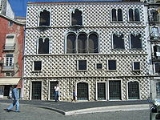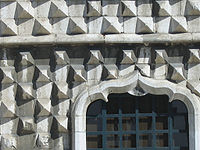
Casa dos Bicos
Encyclopedia

Lisbon
Lisbon is the capital city and largest city of Portugal with a population of 545,245 within its administrative limits on a land area of . The urban area of Lisbon extends beyond the administrative city limits with a population of 3 million on an area of , making it the 9th most populous urban...
, in Portugal
Portugal
Portugal , officially the Portuguese Republic is a country situated in southwestern Europe on the Iberian Peninsula. Portugal is the westernmost country of Europe, and is bordered by the Atlantic Ocean to the West and South and by Spain to the North and East. The Atlantic archipelagos of the...
. The house, built in the early 16th century in the Alfama
Alfama
Alfama is the oldest district of Lisbon, spreading on the slope between the Castle of Lisbon and the Tejo river. Its name comes from the Arabic Al-hamma, meaning fountains or baths...
neighbourhood, has a curious façade of Renaissance
Renaissance architecture
Renaissance architecture is the architecture of the period between the early 15th and early 17th centuries in different regions of Europe, demonstrating a conscious revival and development of certain elements of ancient Greek and Roman thought and material culture. Stylistically, Renaissance...
and Manueline
Manueline
The Manueline, or Portuguese late Gothic, is the sumptuous, composite Portuguese style of architectural ornamentation of the first decades of the 16th century, incorporating maritime elements and representations of the discoveries brought from the voyages of Vasco da Gama and Pedro Álvares Cabral...
influence. It has survived the disastrous 1755 Lisbon Earthquake
1755 Lisbon earthquake
The 1755 Lisbon earthquake, also known as the Great Lisbon Earthquake, was a megathrust earthquake that took place on Saturday 1 November 1755, at around 9:40 in the morning. The earthquake was followed by fires and a tsunami, which almost totally destroyed Lisbon in the Kingdom of Portugal, and...
that destroyed much of the city.
The Casa dos Bicos was built around 1523 by Brás de Albuquerque (1501-1581), son of the first governor of Portuguese India
Portuguese India
The Portuguese Viceroyalty of India , later the Portuguese State of India , was the aggregate of Portugal's colonial holdings in India.The government started in 1505, six years after the discovery of a sea route to India by Vasco da Gama, with the nomination of the first Viceroy Francisco de...
, Afonso de Albuquerque
Afonso de Albuquerque
Afonso de Albuquerque[p][n] was a Portuguese fidalgo, or nobleman, an admiral whose military and administrative activities as second governor of Portuguese India conquered and established the Portuguese colonial empire in the Indian Ocean...
. Brás de Albuquerque had spent some years in Italy
Italy
Italy , officially the Italian Republic languages]] under the European Charter for Regional or Minority Languages. In each of these, Italy's official name is as follows:;;;;;;;;), is a unitary parliamentary republic in South-Central Europe. To the north it borders France, Switzerland, Austria and...
, where he could get first hand contact with Italian Renaissance architecture
Renaissance architecture
Renaissance architecture is the architecture of the period between the early 15th and early 17th centuries in different regions of Europe, demonstrating a conscious revival and development of certain elements of ancient Greek and Roman thought and material culture. Stylistically, Renaissance...
. He presumably saw urban palaces like the Palazzo dei Diamanti
Palazzo dei Diamanti
Palazzo dei Diamanti is a palace located on Corso Ercole I d'Este 21 in Ferrara, northern Italy. It is one of the most famous palaces in Italy, as well one of the most influential examples of European Renaissance architecture.-History:...
, in Ferrara
Ferrara
Ferrara is a city and comune in Emilia-Romagna, northern Italy, capital city of the Province of Ferrara. It is situated 50 km north-northeast of Bologna, on the Po di Volano, a branch channel of the main stream of the Po River, located 5 km north...
, that have façades covered with diamond-shaped spikes. Upon his return to Portugal, Brás de Albuquerque built the Casa dos Bicos with a façade featuring "diamonds" like in the Italian palace, but incorporating Manueline
Manueline
The Manueline, or Portuguese late Gothic, is the sumptuous, composite Portuguese style of architectural ornamentation of the first decades of the 16th century, incorporating maritime elements and representations of the discoveries brought from the voyages of Vasco da Gama and Pedro Álvares Cabral...
(Portuguese late Gothic
Gothic architecture
Gothic architecture is a style of architecture that flourished during the high and late medieval period. It evolved from Romanesque architecture and was succeeded by Renaissance architecture....
) windows and portals.

Bacalhau
Bacalhau is the Portuguese word for codfish and—in a culinary context—dried and salted codfish. Fresh cod is referred to as bacalhau fresco .-Use:...
). Around 1960 the house was acquired by the Lisbon Municipality.
In the 1980s the house was restored and partially rebuilt. The two upper storeys of the current main façade were rebuilt based on pre-1755 drawings and paintings, which showed a Renaissance loggia
Loggia
Loggia is the name given to an architectural feature, originally of Minoan design. They are often a gallery or corridor at ground level, sometimes higher, on the facade of a building and open to the air on one side, where it is supported by columns or pierced openings in the wall...
on the third floor and the Manueline-style windows. Archaeological excavations were carried out inside the house, revealing remnants of Roman
Hispania
Another theory holds that the name derives from Ezpanna, the Basque word for "border" or "edge", thus meaning the farthest area or place. Isidore of Sevilla considered Hispania derived from Hispalis....
and Moorish periods.

